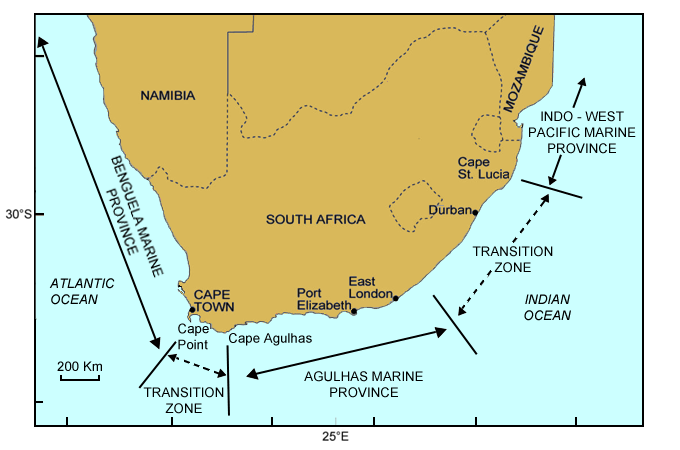Seaweeds of the South African South Coast


Biogeography is the study of the patterns and causes of the geographical distribution of an organism or group of organisms. Knowing what grows where is important for conservation and helps us to understand how the broader ecosystem might work, and will help us to measure and perhaps predict the effects of climate change.

Figure3. The coast of southern Africa showing seaweed marine biogeographical provinces (from Anderson et al. 2009).
The South African coast spans a range of inshore temperature regimes, from the tropical waters of northern Kwazulu-Natal to the cold waters of the west coast, with a corresponding change in the biogeographical affinities of the organisms that inhabit this coast. Based on a study of 318 common species (including 116 seaweeds), Stephenson (1948) divided the coast into three biogeographic provinces: the cold temperate west coast, the warm temperate south coast, and the subtropical east coast. Subsequent studies have refined his concepts of general biogeographic divisions (see for example Lombard et al. 2004), and different groups of organisms sometimes show somewhat different biogeographic patterns, but our current understanding of seaweed distributions indicates three distinct biogeographic provinces, with overlap regions between them (see Figure 3).
The Agulhas Marine Province covers most of the coast we are dealing with here, and extends from Cape Agulhas ( a fairly distinct boundary)to a broader and less distinct boundary area in the eastern part of the Eastern Cape Province: probably around the central-northern Transkei. Its western overlap is with the cool-temperate Benguela Marine Province, and extends from Cape Agulhas to about Cape Point. Its eastern overlap zone is more difficult to define. From the northern Transkei running up through Kwazulu-Natal, the south coast seaweed flora, with its high percentage of endemics, is gradually replaced by species with tropical affinities (Bolton et al. 2004): north of Cape St Lucia the flora is overwhelmingly Indo-West Pacific in nature. Very few seaweeds are endemic to the southern and central Kwazulu-Natal coast (around 2% of total species), which is one of the reasons to regard it as a transition zone rather than a biogeographic province (Bolton et al. 2004).”
Seaweed communities change from east to west within the Agulhas Marine Province, with sub-regions detectable in terms of presence/absence of species (Anderson et al. 2009). A primary division in the Port Alfred/Great Fish River area indicates some difference between the western (cooler-water) and eastern (warmer-water) communities. This, and further (lower-level) subdivisions in seaweed distributions were used by Anderson et al. (2009) to assess the effectiveness of Marine Protected Areas on this coast.
References
Anderson, R.J., Bolton, J. J. & Stegenga, H. 2009. Using the biogeographic distribution and diversity of seaweed species to test the efficacy of marine protected areas in the warm temperate Agulhas Marine Province, South Africa. Diversity and Distributions, 15: 1017-1027.
Bolton, J. J., Leliaert, F, DeClerck, O, Anderson, R.J.,Stegenga, H., Engledow, H.E. & Coppejans, E. (2004) Where is the western limit of the tropical Indian Ocean seaweed flora? An analysis of intertidal seaweed biogeography on the east coast of South Africa. Marine Biology, 144, 51-59.
Lombard, A.T., Strauss, T., Harris, J., Sink, K., Attwood, C. & Hutchings, L. (2004) South African National Spatial Biodiversity Assessment – marine component. South African National Biodiversity Institute Technical Report, 4, 96 pp. + appendices.
Stephenson, T.A. 1948. The constitution of the intertidal fauna and flora of South Africa, Part 3. Annals of the Natal Museum, 11(2), 207- 324 + 2 plates.
Citing this publication:
Anderson RJ, Stegenga H, Bolton JJ. 2016. Seaweeds of the South African South Coast.
World Wide Web electronic publication, University of Cape Town, http://southafrseaweeds.uct.ac.za; Accessed on 28 December 2025